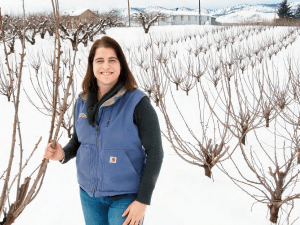By Allison Cloo
Oregon Aglink welcomed new president Megan Thompson at its annual membership meeting at the Northwest Ag Show in January.
Currently based in The Dalles at Cascade Cherry Growers where she works as a field representative, Thompson originally hails from the Mt. Tabor neighborhood of Portland. Her early experiences with Outdoor School and the Green Thumb program took her to different greenhouses and environments that had her looking beyond the four walls of a regular classroom or office.
A major in horticulture and a minor in crop and field sciences at Oregon State University led Thompson to internships with food processors, including a stint in Hermiston with potatoes. “I fell in love with field work and being outside,” says Thompson, and her current work in The Dalles allows for her to pursue that passion.

While winter months may mean more office work and keeping up to date on industry research, the growing season sees Thompson putting plenty of miles on her truck as she drives between orchards and processing facilities. As a field rep and director of field services, she is a bridge between the branches and the packing boxes: “What does the quality look like? What sizes are coming up? When is that load due? What’s coming next?”
Cherries were actually what brought Thompson to the Oregon Aglink board of directors and executive committee—at least in a roundabout way. She met fellow board member and past Oregon Aglink president Molly McCargar through their connections at Oregon Cherry Growers, and McCargar convinced her to join the team of people that support and develop programs to educate Oregonians about agriculture.
For Thompson, programs like Adopt a Farmer made a lot of sense: “it resonates with being a city kid and coming to agriculture” as opposed to being born into a multi-generational heritage of farming. That story of arriving at agriculture rather than being born in agriculture is not all that uncommon, though, and programs like Adopt a Farmer expose more students, teachers, and parents to the realities and possibilities of farming and ranching in Oregon.
Where Adopt a Farmer-style education has branched into adult outreach and farm tours with the newer Farmers Share program, Thompson sees Oregon Aglink making the right moves. “It’s really intriguing to me,” she says, “How do we now take it to the adult level of how to teach Portland what farmers really do? How do we show what other options are out there for high schoolers and people looking for different careers?”
And she sees work to be done on bridges within agriculture as well. The Oregon Aglink board of directors, for example, is big and diverse. So while “some people know each other and grew up with each other,” creating some connections through past experiences, Thompson also wants to know, “how can we network beyond the board meetings?” There are members from many different industries, Thompson emphasizes, and there is room to learn more about each other.
Going into her year as president Thompson is looking at ways that agriculture can reach out to consumers but also break down internal siloes. Her time in the first class of the REAL Oregon program led to many new connections with others in agriculture, fishing, and forestry. Thirty participants from different regions and industries within Oregon attended five sessions around the state to learn more about the state of natural resources and agricultural management.
At REAL Oregon, it was apparent that struggles in one industry or region, like bans on aerial spraying, can foreshadow legal challenges elsewhere. On the other hand, solutions for one group might be shared to benefit many.
So, while Thompson balances her work in The Dalles with her year of service as president of Oregon Aglink, she’s hoping that other producers and processors also find the means to learn more about each other and the Oregonians they’re trying to reach. As tough as it can be to find the time to connect, there’s always a need.